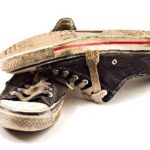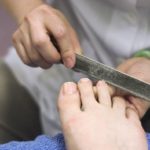Shoes, stockings and in-shoe devices – The tools of foot comfort
 An ingrown toe nail, a painful callous, a sore heel or a throbbing knee? When the aggravation persists what can you do? Putting it in perspective, you will often find there is a trail of evidence leading up to one of these incidents or injuries. A sore nail bed or cuticle may come from a shallow toe box or a short shoe fitting. A callous is an indication of friction or movement inside the shoe. Heel, knee, hip or back pain may come from poor alignment that can sometimes be seen by distortion or unusual wear in shoes. Getting into a new or better quality shoe is sometimes all that is necessary. Many of the painful or debilitating conditions can be diagnosed by your Family Physician or evaluated by a Health Care Professional familiar with body mechanics. They can then refer you to someone who can help.
An ingrown toe nail, a painful callous, a sore heel or a throbbing knee? When the aggravation persists what can you do? Putting it in perspective, you will often find there is a trail of evidence leading up to one of these incidents or injuries. A sore nail bed or cuticle may come from a shallow toe box or a short shoe fitting. A callous is an indication of friction or movement inside the shoe. Heel, knee, hip or back pain may come from poor alignment that can sometimes be seen by distortion or unusual wear in shoes. Getting into a new or better quality shoe is sometimes all that is necessary. Many of the painful or debilitating conditions can be diagnosed by your Family Physician or evaluated by a Health Care Professional familiar with body mechanics. They can then refer you to someone who can help.
 Appropriate footwear is a good starting place. Deep toe box, firm heel counter, cushioned rocker soles and foot friendly seam placement are all features that should be considered. Slip on shoes may be convenient but an adjustable closure is more secure for walking and standing. If you have difficulty lacing due to back or hand disability Velcro closures might help, although these will tend to loosen with vigorous activity. Keeping your nails trimmed and callouses treated is important. It can give you fewer causes for trouble and allow you to see where friction and pressure are occurring. If you can’t look after your own feet a Podiatrist or foot care nurse can help.
Appropriate footwear is a good starting place. Deep toe box, firm heel counter, cushioned rocker soles and foot friendly seam placement are all features that should be considered. Slip on shoes may be convenient but an adjustable closure is more secure for walking and standing. If you have difficulty lacing due to back or hand disability Velcro closures might help, although these will tend to loosen with vigorous activity. Keeping your nails trimmed and callouses treated is important. It can give you fewer causes for trouble and allow you to see where friction and pressure are occurring. If you can’t look after your own feet a Podiatrist or foot care nurse can help.
Stockings are often overlooked as a comfort solution. Avoid patterned or ribbed knits. Many synthetics have real advantages with fibre  blends offering unique properties for cushion, wicking and friction reduction. Cotton and wool may be the standard but there is great variation in products. Just because the label says “diabetic sock” doesn’t guarantee quality. All cotton becomes more abrasive with laundering and knowing when to discard and move to a new pair is critical. Often a synthetic yarn with anti-bacterial treatments will be a better long term buy. There is likely to be more significant difference between a $5 and $15 stocking than the price.
blends offering unique properties for cushion, wicking and friction reduction. Cotton and wool may be the standard but there is great variation in products. Just because the label says “diabetic sock” doesn’t guarantee quality. All cotton becomes more abrasive with laundering and knowing when to discard and move to a new pair is critical. Often a synthetic yarn with anti-bacterial treatments will be a better long term buy. There is likely to be more significant difference between a $5 and $15 stocking than the price.
In shoe devices such as cushioned foot-beds or custom orthotics are helpful in repositioning the foot and  alleviating pressure and friction that lead to joint and muscle pain or callouses and corns. They can often improve ankle, knee, hip and back posture and reduce symptoms. Foot orthotics are assessed, designed and fitted by a certified Health Care Professional familiar with body mechanics and how the bones, joints, ligaments, tendons and muscles respond to activity. These devices can range from soft through flexible to rigid depending on activity level, weight, occupation or shoe type so they are truly particular to you and your lifestyle. If you experience pain or disability and this a limiting factor in your activities or enjoyment of them, talk to your Physician about getting a biomechanical assessment orthopedic footwear or foot orthotics.
alleviating pressure and friction that lead to joint and muscle pain or callouses and corns. They can often improve ankle, knee, hip and back posture and reduce symptoms. Foot orthotics are assessed, designed and fitted by a certified Health Care Professional familiar with body mechanics and how the bones, joints, ligaments, tendons and muscles respond to activity. These devices can range from soft through flexible to rigid depending on activity level, weight, occupation or shoe type so they are truly particular to you and your lifestyle. If you experience pain or disability and this a limiting factor in your activities or enjoyment of them, talk to your Physician about getting a biomechanical assessment orthopedic footwear or foot orthotics.
This article authored by Terry Trask C. Ped(C)
Appointment
REQUEST
APPOINTMENT
